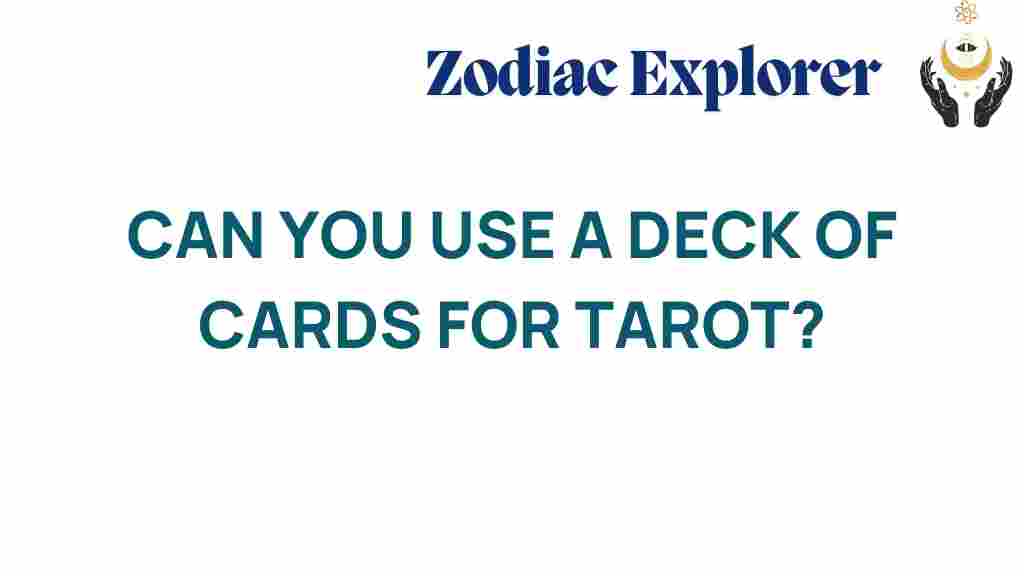Unlocking the Secrets: Can a Deck of Cards Replace Tarot?
For centuries, tarot cards have been a powerful tool for divination, spirituality, and fortune-telling. The rich symbolism and intuitive nature of tarot readings have captivated many seeking guidance and insight into their lives. However, can a simple deck of cards also serve this purpose? In this article, we will explore the potential of a regular deck of cards as a substitute for tarot, examining their similarities, differences, and the unique insights they can provide into our spiritual journeys.
The Basics of Tarot and Deck of Cards
Tarot cards typically consist of 78 cards divided into two main sections: the Major Arcana and the Minor Arcana. Each card carries its own meaning, rooted in rich symbolism and archetypal imagery. In contrast, a standard deck of cards contains 52 playing cards, which are divided into four suits: hearts, diamonds, clubs, and spades. Each suit contains cards numbered from 2 to 10, along with a jack, queen, king, and ace.
Despite the apparent differences, both tarot and a deck of cards can be used for divination, relying on intuition and interpretation of card meanings. Here, we will delve deeper into how a deck of cards can replicate the functions of tarot.
Understanding the Symbolism
Both tarot and playing cards are steeped in symbolism. In tarot, every card has images and symbols that carry specific meanings. For instance, The Fool represents new beginnings and spontaneity, while The Tower signifies upheaval and revelation.
In a standard deck of cards, the symbolism can be less explicit, but it still exists. For example:
- Hearts: Often associated with emotions, love, and relationships.
- Diamonds: Represent material wealth and practical matters.
- Clubs: Symbolize action, ambition, and growth.
- Spades: Related to challenges, conflict, and transformation.
When using a deck of cards for divination, you can apply the same intuitive approach to interpreting the meanings of the suits and numbers, akin to how you would interpret tarot cards.
Card Meanings: Tarot vs. Deck of Cards
Tarot cards have established meanings that are widely recognized in the spiritual community. However, a deck of cards can also be interpreted through a similar lens by associating meanings with numbers and suits. Here’s a basic overview of how card meanings can align:
- Aces: New beginnings, opportunities.
- Twos: Choices and partnerships.
- Threes: Growth and collaboration.
- Fours: Stability and foundation.
- Fives: Conflict or change.
- Sixes: Harmony and balance.
- Sevens: Reflection and assessment.
- Eights: Movement and action.
- Nines: Completion and fulfillment.
- Jacks: Youthful energy and exploration.
- Queens: Nurturing and intuition.
- Kings: Authority and control.
By understanding these card meanings, you can begin to interpret a deck of cards similarly to tarot, tapping into the same intuitive insights.
Step-by-Step Guide to Using a Deck of Cards for Divination
If you’re interested in exploring the use of a standard deck of cards for divination, follow this step-by-step guide:
1. Preparation
Before beginning your reading, find a quiet space where you can focus. Take a few deep breaths to center yourself. Set an intention for your reading, whether it’s seeking clarity on a specific situation or general insight.
2. Shuffle the Deck
Shuffle the deck thoroughly while thinking about your question or intention. This process helps to infuse your energy into the cards.
3. Draw the Cards
Decide how many cards to draw based on your question. For a simple inquiry, drawing three cards can provide a past, present, and future perspective. For more complex questions, you may want to draw more cards.
4. Interpret the Cards
Look at the cards you’ve drawn and begin to interpret their meanings based on the suits and numbers. Consider how they relate to your question. Trust your intuition as you explore the connections between the cards.
5. Reflect
Take time to reflect on the reading. Consider journaling your thoughts and insights. This process can deepen your understanding and enhance your spiritual growth.
Troubleshooting Tips for Card Interpretations
When using a deck of cards for divination, you may encounter challenges in interpretation. Here are some troubleshooting tips to enhance your experience:
- Feeling Stuck: If you’re having difficulty interpreting a card, take a moment to meditate on it. Consider what emotions or thoughts arise when you view the card.
- Overthinking: Trust your intuition. Sometimes the first impression you have of a card holds the most significance.
- Conflicting Meanings: If the meanings seem contradictory, think about how they might coexist or relate to different aspects of your life.
- Seek Guidance: If you’re unsure about your interpretations, consider reaching out to a community of fellow readers or consult resources on card meanings.
Conclusion: Embracing the Power of Intuition
While tarot cards offer a rich and complex system for divination, a standard deck of cards can also unlock profound insights when used with intention and intuition. By embracing the symbolism and meanings inherent in both systems, you can tap into your spiritual journey, guiding you through life’s challenges and celebrations.
Ultimately, whether you choose tarot or a deck of cards, the power of divination lies in your ability to connect with your intuition. Trust yourself to interpret the messages that arise and allow the cards to guide you on your path.
For more resources on tarot and divination, check out this comprehensive guide to tarot interpretations. If you’re looking to dive deeper into card meanings, visit this external resource for additional insights.
In the end, the choice between tarot and a deck of cards comes down to personal preference and exploration. So, gather your cards, set your intentions, and unlock the secrets that await you!
This article is in the category Myths and created by ZodiacExplorer Team
